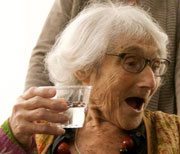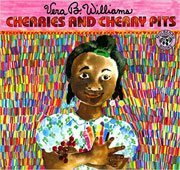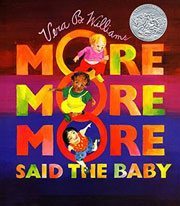by Jacqueline Briggs Martin and Phyllis Root

Jacqueline Briggs Martin: Some writers teach us craft. Some writers inspire us. Vera B. Williams does both. As part of celebrating her wonderful life and career we want to take another look at her lovely stories and her busy life. One of the many remarkable things about her books is that they “erupt” (as she said) from the activities of her life.
 Three Days on the River in a Red Canoe was based on Williams’ own 500-mile journey down the Yukon River. It starts when a kid notices a canoe for sale in a neighbor’s yard. His mom and her sister and his cousin pool their money and buy it. This is a family that thinks about buying something. There is not a lot of cash lying around. Amber Was Brave Essie Was Smart gives readers a loving family (based on Williams and her sister) whose father is in prison.
Three Days on the River in a Red Canoe was based on Williams’ own 500-mile journey down the Yukon River. It starts when a kid notices a canoe for sale in a neighbor’s yard. His mom and her sister and his cousin pool their money and buy it. This is a family that thinks about buying something. There is not a lot of cash lying around. Amber Was Brave Essie Was Smart gives readers a loving family (based on Williams and her sister) whose father is in prison.
One of her best-loved stories, A Chair for My Mother, grew out of her experience growing up “in a family that had a lot of trouble making a living.” She never forgot that. In a Greenwillow publicity interview she recounted that her mother worked very hard, just as Rosa’s mother, and actually did buy herself a chair so she would have a place to sit when she was tired. Williams said, “I’m very proud of having introduced a kind of character and family and experience to children’s books… people who work for a living in very ordinary professions.”
Phyllis Root: Yes, one of the many things I love about Vera B. Williams is how both her work and her life celebrate everyday people, working class people, people with problems, family, community.
 Jacqueline Briggs Martin: And that focus on community comes from her life, too. Her mother was very community-minded. She was one of a group of people who would gather on the sidewalk during the Depression when a family’s furniture was being repossessed and “defy the bailiff” by carrying that furniture back to the family’s apartment. I love picturing that and think the two page spread in A Chair for My Mother in which neighbors bring pieces of furniture to Rosa’s family after the fire must be partly inspired by William’s early neighbors carrying furniture back upstairs.
Jacqueline Briggs Martin: And that focus on community comes from her life, too. Her mother was very community-minded. She was one of a group of people who would gather on the sidewalk during the Depression when a family’s furniture was being repossessed and “defy the bailiff” by carrying that furniture back to the family’s apartment. I love picturing that and think the two page spread in A Chair for My Mother in which neighbors bring pieces of furniture to Rosa’s family after the fire must be partly inspired by William’s early neighbors carrying furniture back upstairs.
Phyllis Root: Williams said that as a child she didn’t understand her mother’s need for “new cushiony chair.” In A Chair for my Mother Rosa, her mother, and grandmother all work together saving nickels and dimes and quarters in a jar to buy a chair for the whole family. Williams transforms her childhood experience, just as she worked to transform the world — she was a member of the War Resistor’s League and went to prison for protesting the Vietnam War. She not only wrote about what she believed, she lived those beliefs.
 Cherries and Cherry Pits, too, is about transformation. As a child, Vera drew pictures and told stories about them, just as Bidemmi does in Cherries and Cherry Pits. In each story Bidemmi tells, someone shares cherries — a father with his children, a grandmother with her parrot, a boy with his little sister. And all of them are “eating cherries and spitting out the pits.” In the last story she tells, Bidemmi, too, has a bag of cherries. She eats the cherries and plants the pits in her “junky old yard,” where they grow into trees full of cherries, and people come from “Nairobi and Brooklyn, Toronto and Saint Paul” to eat those cherries and spit out the pits, which grow “until there is a whole forest of cherry trees right on our block.”
Cherries and Cherry Pits, too, is about transformation. As a child, Vera drew pictures and told stories about them, just as Bidemmi does in Cherries and Cherry Pits. In each story Bidemmi tells, someone shares cherries — a father with his children, a grandmother with her parrot, a boy with his little sister. And all of them are “eating cherries and spitting out the pits.” In the last story she tells, Bidemmi, too, has a bag of cherries. She eats the cherries and plants the pits in her “junky old yard,” where they grow into trees full of cherries, and people come from “Nairobi and Brooklyn, Toronto and Saint Paul” to eat those cherries and spit out the pits, which grow “until there is a whole forest of cherry trees right on our block.”
Jacqueline Briggs Martin: And we can learn craft from this story, too. Look at this character description:
This is the door to the subway and THIS is a man leaning
on the door… His face is a nice face. But it is also not so
nice. He has a fat wrinkle on his forehead. It’s like my
mother’s wrinkle. It’s from worrying and worrying, my
mother says. And his neck is thick and his arms are thick
with very big, strong muscles. His shirt is striped blue and
white and his skin is dark brown and in his great big hands
he has a small white bag. This man looks so strong I think
he could even carry a piano on his head. But he is only
carrying this little white bag…
What great information we get about the Bidemmi and her mother from the description of this man who has a fat wrinkle “from worrying and worrying.” Who could ever forget a man strong enough to carry a piano on his head?
 Phyllis Root: Williams believed that if children’s needs are met in “the way of love and adventures, we would have a lot more happiness in the world.” Her book “More, More, More,” Said the Baby: Three Love Stories joyously celebrates three babies whose needs are met, (and includes a white grandmother and her brown grandchild, one of the first times such a family was shown in a picture book).
Phyllis Root: Williams believed that if children’s needs are met in “the way of love and adventures, we would have a lot more happiness in the world.” Her book “More, More, More,” Said the Baby: Three Love Stories joyously celebrates three babies whose needs are met, (and includes a white grandmother and her brown grandchild, one of the first times such a family was shown in a picture book).
In an interview in Show Me a Story, Conversations with 21 of the World’s Most Celebrated Illustrators compiled and edited by Leonard S. Marcus, Williams talks about luck, a word that shows up not only in Lucky Song but also in A Chair for My Mother when the grandmother thanks the neighbors for all their help moving into and furnishing their new apartment. “It’s lucky we’re young and can start all over,” she says. Even the grocery whose owners give away watermelons in The Great Watermelon Birthday is named Fortuna’s Fruits.
 Our family has been lucky to know Williams’s books for many years. Since we discovered her first—It’s a Gingerbread House: Bake It, Build It, Eat It! — we’ve been making gingerbread houses and delighting in her stories.
Our family has been lucky to know Williams’s books for many years. Since we discovered her first—It’s a Gingerbread House: Bake It, Build It, Eat It! — we’ve been making gingerbread houses and delighting in her stories.
Here’s hoping many, many more children will be lucky enough to read and enjoy her books and to grow up in a peaceful world where the grown-ups make sure that every child’s needs are met. A world Vera B. Williams envisioned, worked for, and made into beautiful, deeply felt books.
Here’s a list of her books, all published by Greenwillow:
- Amber Was Brave, Essie Was Smart: The Story of Amber and Essie Told Here in Poems and Pictures (2001)
- A Chair for Always (2009)
- A Chair for My Mother (1982)
- Cherries and Cherry Pits (1986)
- It’s a Gingerbread House: Bake It, Build It, Eat It! (1978)
- Lucky Song (1997)
- “More, More, More,” Said the Baby: Three Love Stories (1990)
- Music, Music for Everyone (1984)
- Scooter (1993)
- Something Special for Me (1983)
- Stringbean’s Trip to the Shining Sea, with Jennifer Williams (1988)
And here’s where you can order a 1989 Peace Calendar (365 reasons not to have another war) by Grace Paley and Vera B. Williams. (Extra bonus: the 1989 calendar repeats in 2017, but even if it didn’t, it’s well worth buying for the art and writing and to support the War Resisters League.)

Bravo for Vera B. Williams! Somehow, I missed “More More More, Said the Baby,” when it came out, so when I saw it for the first time, I wept, seeing myself and my little brown grandbaby in a picture book. And of course she and Grace Paley were friends. I was so lucky to have Grace as my writing teacher in college, but she often missed our appointments because she was off at a protest (probably with Vera). It’s hard to think of them resting, but may they be in peace.
I wish I had known them. They were such an example of living the writing live, or writing the lived life.